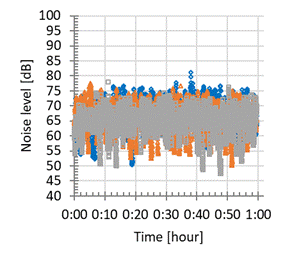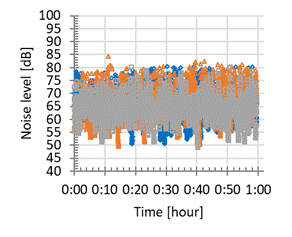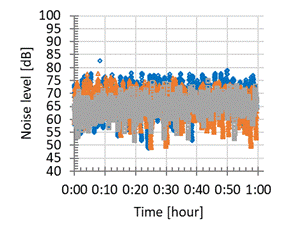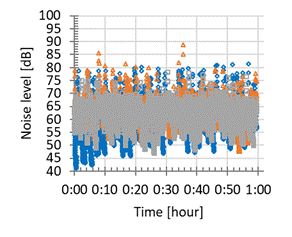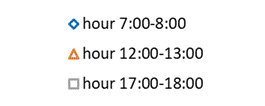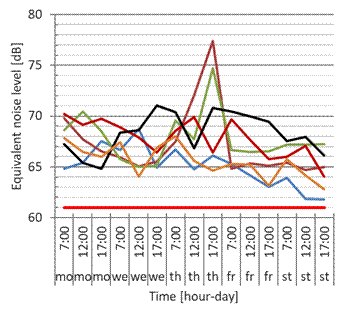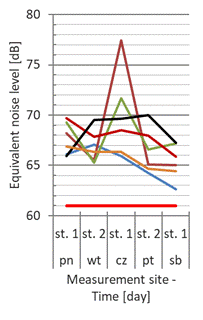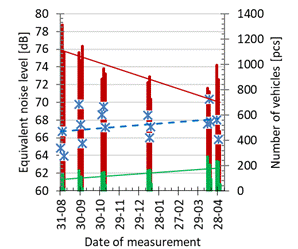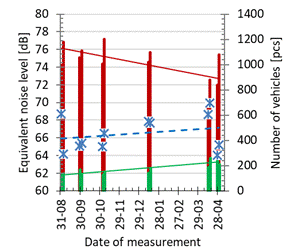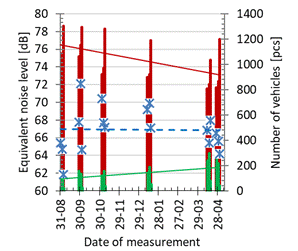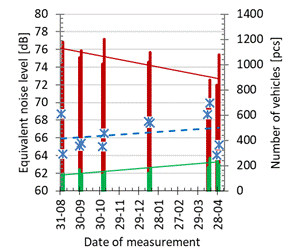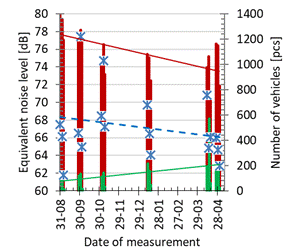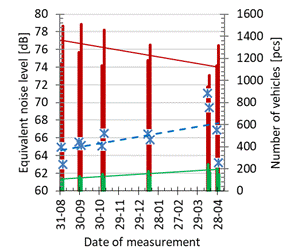Article
citation information:
Gruchot, A., Zydroń,
T. Assessment
of the acoustic climate on the example of the road in Michałowice
(Poland). Scientific Journal of Silesian
University of Technology. Series Transport. 2025, 127, 103-128. ISSN: 0209-3324. DOI: https://doi.org/10.20858/sjsutst.2025.127.7
Andrzej GRUCHOT[1], Tymoteusz ZYDROŃ[2]
ASSESSMENT OF THE
ACOUSTIC CLIMATE ON THE EXAMPLE OF THE ROAD IN MICHAŁOWICE (POLAND)
Summary. The aim of the research
was to assess the acoustic climate along the DK7 national road in Michałowice (Kraków district, Poland). The climate
assessment was carried out during the period from September to May at two
measurement sites located at a distance of 11.5 and 27.0 m from the road. The
scope of the study included measuring the intensity of noise, recording the
number of light and heavy vehicles, measuring the temperature of as well as air
and the type of precipitation. The results of noise intensity measurements
showed numerous cases of exceeding the permissible equivalent noise level for
single-family housing areas. The machine learning methods used showed that the
noise level was influenced by air temperature, snowfall, and plant vegetation.
Significantly lower values of the equivalent noise level were obtained on
weekends, indicating that commercial road traffic prevailed in the analyzed road section.
Keywords: road traffic noise, noise pollution, equivalent sound pressure levels,
atmospheric conditions
1. INTRODUCTION
Noise and its level have become one of the
factors that increasingly characterize the areas where people live, work, or
relax. Noise is the biggest problem for city dwellers, but it is also recorded
in rural areas, as well as in city parks and even in national parks and
reserves. Long-term exposure to unwanted sounds results in hearing damage and
deterioration of mental health and general health.
Noise is defined as unpleasant and undesirable
sounds with frequencies from 16 Hz to 16 kHz and with an intensity that causes
nuisance to the surroundings [13]. Noise is estimated to be the world's biggest
problem after air pollution. This pollution comes from the places where people
live and work. The sources of noise are mainly industrial and service
activities, as well as transport. Sound, in physical terms, is the mechanical
deformation of an elastic medium (such as a gas or liquid) moving in the form of
a wave. Sound can be described as the propagation of small pressure
disturbances and density fluctuations in such a medium. The basic quantity that
describes sound is its frequency and the amplitude of the sound pressure.
The definition of noise contained in the
Environmental Protection Law [13] does not include the important
psychophysiological aspect due to which the specific concept of
"sound" is transformed into the concept of "noise".
Directive 2002/49/EC [12] treats the concept of noise more broadly, stating
that "environmental noise" means unwanted or harmful sounds caused by
human activities. Depending on the source of origin, a distinction is made
between traffic noise (road or street noise, aircraft, railway, and tram
noise), industrial noise (metal and wood processing, construction, ventilation,
and air conditioning installations), and municipal noise (catering
establishments, concerts, sports competitions).
Road noise is estimated to be the most common
type of noise. According to the Strategic Noise Mapping database, one in five
people in Europe are exposed to chronic noise levels that can cause adverse
health effects. Around 95 million people in the European Union are estimated to
be exposed to harmful levels of road noise, and at least 20% of the urban
population is exposed to noise levels considered harmful to health. At least 18
million people are very irritated and 5 million have severe sleep disturbances
due to long-term exposure to transport noise. Furthermore, it is estimated that
long-term exposure to transport noise causes approximately 11000 premature
deaths and, 40000 new cases of coronary heart disease [53]. In Iceland, Norway,
Switzerland, and Turkey, one in four households reports being bothered by the
noise of neighbors or from the street, with the
proportion of the population complaining about noise ranging from 12% (in
Hungary, Iceland, Ireland, and Norway) to 31% (in Cyprus and Romania). The World
Health Organization (WHO) estimates that approximately 40% of the population is
exposed to road noise exceeding 55 dB, 20% are exposed to noise exceeding 65 dB
during the day, and more than 30% are exposed to noise exceeding 55 dB at night
[56]. Road noise is also closely related to air pollution and its impact on
human health [3, 17, 42], as well as to animals living on land and in water
[44, 26]. Long-term exposure to noise is harmful to physical and mental health.
Excessive noise levels cause sleep disorders, which in turn leads to
cardiovascular diseases, as well as irritation, learning difficulties, hearing
impairment and tinnitus, chronic fatigue, irritability, stress, loss of
concentration and other diseases [2, 20, 52].
Road noise is one of the main factors that
degrade the environment, and its impact is increasing due to the construction
of new roads and communication routes. Therefore, the effects of its impact are
felt by an increasing number of residents. The level of road noise is
influenced by the density of roads and streets in urban areas, and outside
cities, highways and expressways, as well as national and some provincial
roads. The condition of the road surface and the means of transport on the
roads are also important. The noise caused by the engine, the rolling noise
(contact of the tire with the ground), and the aerodynamic noise (turbulent air
flow around the body of the car) are important factors influencing the noise
level. In the case of heavy vehicles, there are also vibrations of some
elements (e.g., vibrations of semitrailers or containers) when driving on
uneven surfaces.
The type of noise source will determine the
acoustic climate of a given place, which is most often characterized by the
sound level occurring in a given area. Acoustic climate is a set of acoustic
phenomena that occur in the environment and are caused by noise coming from
sources located in this environment. Acoustic climate is assessed using the
sound level of all sources that cause it in a given environment. The
harmfulness of noise depends on the level of sound pressure and the duration of
exposure, that is, the so-called noise dose [7]. Acoustical climate, especially
under local conditions, is characterized by strong changes in time and space.
It depends mainly on the degree of saturation of a given environment with
devices and vehicles, as well as the urban layout characterizing the local
environment and the layout of housing estates with green areas, communication
system, commercial and service facilities and production plants. Therefore,
environmental noise is attracting more and more attention and is regulated by
an increasingly demanding legal framework because its effects on the population
are worrying [25, 40].
In Poland, road noise measurements are performed
as part of environmental monitoring or control and by road management
institutions. Based on the results of noise level measurements, acoustic
condition assessments are carried out. Long-term trends in environmental noise
in Poland indicate an increase in traffic noise, especially road and aircraft
noise. The increase in the risk of road noise in recent years is mainly related
to the construction of new roads and elements of the road infrastructure and
the rapid increase in the number of vehicles [19].
The monitoring of noise level showed that in
2020, road noise in Poland was a threat primarily in urbanized areas and was
felt by an increasing number of residents [20]. Of almost 200 km of roads, only
4% of roads had road noise emissions in the range of up to 60 dB, that is,
emissions that did not exceed allowed sound levels during the day in
residential areas adjacent to the roads. The highest percentage of streets with
exceeded noise emissions was found in the cities of the Lower Silesian, Lubuskie, Lesser Poland and Podlaskie
voivodeships (100% each) and the West Pomeranian voivodeship (99%). The lowest
percentage was in the cities of the Lublin Voivodeship (69%) and the Warmian-Masurian Voivodeship (71%) [20]. The research
results have shown that the greatest impact of traffic noise on the acoustic
climate occurs 200-300 m from the road, and the nuisance of traffic noise
reaches a distance of approximately 500 m from the road [5]. The level of
traffic noise, both in cities and on communication routes in non-urban areas,
is determined by many factors, including vehicle traffic intensity, the
percentage share of trucks in the traffic flow, the speed of vehicles, the
location of the road and the type of surface, the condition of the road, the
topography and types of buildings, the driving style of drivers.
The aim of the study was to evaluate the
acoustic climate on Krakowska Street in Michałowice
(Kraków district, Poland) along the DK7 national road. The evaluation was based
on the calculated equivalent noise level calculated for the time of day.
2.
CHARACTERISTICS OF THE RESEARCH SITE
The
research was carried out in the Michałowice in the
Lesser Poland Voivodeship, Kraków District (Fig. 1). The measuring points were
located on Krakowska Street, which is part of National Road DK7. The
permissible speed of vehicles on the analyzed road
section is
50 km×h-1.

Fig. 1.
Location of Michałowice and the route of the DK7 road
(own study after [54])
In
the research section, the DK7 road has one lane in each direction (Fig. 2). The
measurement sites were located on the western side of the road. On the eastern
side of the road, there is a gravel bicycle path, which is separated from the
road by a 0.5 m wide shoulder. On the opposite side of the measurement site,
there is a steep exit from Spokojna Street. This may
generate increased noise levels as many drivers have difficulty exiting this
street. A characteristic element of the road in the research section was a
speed camera. Despite the correct marking of the speed camera (vertical road
sign D-51), its frequent activation indicates that the speed limit has been
exceeded. You can also notice that drivers slow down and then accelerate in
front of a speed camera, which also affects the noise level. A certain
limitation to this behavior of drivers is the
pedestrian crossing located 50 m behind the speed camera towards Warsaw.
National
Road DK7 in the section where the research section is located is straight and
flat, and its condition can be assessed as very good. The asphalt was replaced
in 2017, so there were no defects that would generate additional noise.
Approximately 250 m south of the research section, there is a traffic light
that causes traffic jams during heavy traffic. Such situations are mainly
observed in the morning and during heavy tourist traffic. On the western side
of the road, there is a drainage ditch approximately 1 m deep. The ditch is
regularly mowed and is kept in good condition. Next, there is a 2.0 m wide
pedestrian sidewalk. The traffic on the road is small and did not affect the
measurement results.
3. METHODOLOGY
The
noise intensity was measured using a Voltcraft SL-451
decibel meter, which met the requirements of class 2 [38]. The measurement
accuracy was 1.4 dB and the supported frequency range was 31.5 to 8000 Hz. The
sonometer's microphone was protected by a sponge so that the wind did not cause
any disturbances in the measurement.

Fig. 2. Road
infrastructure in the research section (photo by D. Wywiał)
The
measurement sites were located on a private plot, located directly next to the
DK7 road (Fig. 3). The measurement sites were located at two different
distances from the road axis. The site No. 1 (Fig. 4a) was located 11.5 m from
the road axis, directly behind the metal mesh fence. The sonometer was
installed at a height of approximately 0.5 m above the ground surface.
Measurement site No. 2 (Fig. 4b) was located at a distance of 27.0 m from the
road axis at a height of 1.5 m on the wall of a single-family building. In this
case, there was loose vegetation between the DK7 road and the sonometer. Near
the fence there were thujas up to 0.5 m high, then tall pines without branches
up to 2.0 m high, and then vegetation up to 3.0 m high.
Noise
intensity measurements were carried out in six 5-day measurement cycles in
September, October, and November and in January, April, and May. At site 1,
measurements were performed on Mondays, Thursdays, and Saturdays, and at site 2
on Tuesdays and Fridays. The tests started at 7:00, 12:00 and 17:00 and lasted
60 minutes with the sound level recorded every 1 second. Additionally, the
number of passing cars, divided into light and heavy, as well as the
temperature of the air and the type of precipitation, were recorded. The
research was carried out regardless of weather conditions.
The
data collection period was limited to the time of day (6:00-22:00) because it
was expected that peak hours of morning, afternoon, and evening traffic would
fall during this period. The study assumed that noise levels during the day
were more critical than noise levels at night.
The
currently applicable legal acts regulating the permissible levels of noise in
the environment are the regulation of the Minister of the Environment of
October 8, 2012, amending the regulation on permissible noise levels in the
environment [14] and the announcement of the Minister of the Environment of
October 15, 2013 with respect to the announcement of the uniform text of the
Minister of the Environment on permissible noise levels in the environment
[15]. According to this legal act, the permissible levels of environmental
noise caused by roads or railway lines, expressed in equivalent sound levels,
range from 50 to 68 dB during the day (16 hours of reference time) and from 45
to 60 dB at night (8 hours). Table 1 presents the permissible levels of environmental
noise caused by individual groups of noise sources, excluding noise caused by
aircraft take-offs, landings, and flights, as well as power lines, expressed in
the LAeqD and LAeqN
indicators [14]. These indicators apply to the establishment and control of
conditions of use of the environment in relation to one day.

Fig. 3.
Location of measurement sites in relation to the DK7 road (own study after 54])
|
a) measurement site No. 1
|
b) measurement site No. 2
|
Fig. 4. View from the measurement sites onto the DK7
road (photo by D. Wywiał)
The
acoustic climate is determined using acoustic indicators of long-term external
noise and short-term acoustic indicators, corresponding to an equivalent noise
level, and associated with general discomfort and disturbances of sleep. The
equivalent noise level is given in decibels and is the value of the sound
pressure level of a continuous steady sound, corrected according to the
frequency characteristic A, which in a specific reference time interval is
equal to the mean square of the sound pressure of the analyzed
sound with a level varying in time [13]. Most often, the equivalent sound level
is given for the time of day (reference time interval of 16 hours - from 6:00
to 22:00) and night (reference time interval of 8 hours – from 22:00 to 6:00).
The equivalent noise level is expressed by the formula according to [39]:
![]() (1)
(1)
where n –
number of measurements, LA - the average sound level A that occurs during
measurement.
Tab.
1
Permissible levels of environmental noise
caused along roads and railway lines
(own study after [15])
|
No |
Type of terrain |
Permissible noise level in [dB] for roads or railway
lines |
|
|
reference
time interval |
|||
|
time of day LAeq
D |
night time LAeq N |
||
|
1 |
a) Protection zone "A" of the health
resort b) Hospital areas outside the city |
50 |
45 |
|
2 |
a) Areas of single-family housing development b) Development areas related to permanent or
temporary stay for children and young people c) Areas of social welfare homes d) Hospital areas in cities |
61 |
56 |
|
3 |
a) Areas of multifamily housing development
and collective housing b) Farm development areas c) Recreational and relaxation areas d) Residential and service areas |
65 |
56 |
|
4 |
Areas in the inner-city zone of cities with more
than 100,000 inhabitants. inhabitants |
68 |
60 |
For
the tests carried out, the equivalent noise level was determined for the time
of day separately for each of the three measurement hours and then as a total
value for the three measurement hours. For the research area in question,
according to [15], the acceptable noise level in the environment for the day is
61 dB and for the night it is 56 dB.
Measurement
results were subjected to statistical analysis. The influence of the factors
analyzed (day and measurement time, temperature, traffic intensity of light and
heavy vehicles) on the recorded values of the equivalent noise level was
determined. To verify the normality of the distribution, the data were
independently subjected to the Shapiro-Wilk test and then the U-Mann-Whitney
and Kruskal-Wallis tests were used. Later in the analysis, machine learning
methods were used to determine the importance of each of the measured (or
recorded) factors. The Ridge Regression with cross validation (with l2
regularization), support vector machine, multilayer perceptron, k-nearest
neighbor and ensemble method, bagging regressor with the Decision Tree
Regressor as the base estimator were used. To reduce the over- or under-fitting
of the models, the data were split into train and test sets with proportions of
75% and 25%. Qualitative factors (hour of measurement, weather type) were
transformed using a one-zero numeric array. Instead of the number of months,
the cyclical features were created using the cosine function, and the months
were classified as vegetative or nonvegetative. The days were transformed into
weekday or weekend days. The additional factor used in the analysis was the
total number of vehicles, in which each lorry was equivalent to 2.5 passenger
cars. The use of machine learning models allowed us to explain the role of the
set of independent factors in the dependent factor (equivalent to the continuous
sound level). To assess the importance of each factor, Shapley values were
used. The coding of data was used in Python using pandas [34], numpy [22] libraries. Data transformation was performed
using the sklearn library [37] and the feature
engine [18] libraries, while models were implemented with the use of the sklearn library. The Shapley values were determined using
the SHAP library [29, 30]. Other statistical tests were used using the SciPy
library [49], and results visualizations were prepared using matplotlib [24]
and seaborn libraries [50].
4. RESEARCH
RESULTS AND THEIR ANALYSIS
For
the six measurement cycles carried out, the noise level directly from the
sonometer measurements ranged from 41 dB to 111 dB, and its highest values were
recorded in January (Fig. 5). The recorded sound intensity range ranged from
the sound level of a conversation to that of a crowded street. Due to the
requirements established by the regulatory regulations, a further analysis of
the results obtained was carried out for the value of the equivalent noise
level calculated according to (1) for each hour of a given measurement cycle.
Table 2 shows the results of the calculation of the equivalent noise level
calculated for the measurement hours and the total noise level calculated for
the three measurement hours. The table shows the results of calculations and
carried out at measurement site No. 2 in italics, and the minimum and maximum
values of the equivalent noise level for individual measurement hours are
marked in colors.
During
the study period, 884 to 1508 light vehicles and 14 to 170 heavy vehicles were
registered during one hour of measurement. There was a clear downward trend in
the number of heavy vehicles during nonwork days (weekends, holidays), which
was the result of applicable road traffic regulations.
Tab.
2
Summary of calculations of the equivalent
noise level, number of vehicles,
temperature, and type of precipitation for each measurement cycle
|
Date of the
measurement cycle |
Equivalent
noise level [dB] for: |
Number of vehicles
[pcs] |
Tempera-ture
[°] |
Type of precipitation |
|||||
|
hours |
day |
light |
heavy |
||||||
|
date |
Day |
7:00-8:00 |
12:00-13:00 |
17:00-18:00 |
|||||
|
31/08 – 5/09 |
Mo |
64.8 |
65.4 |
67.5 |
65.9 |
3575 |
407 |
17–19 |
lack |
|
Tu |
66.7 |
68.7 |
64.9 |
66.8 |
3227 |
357 |
15–17 |
rain |
|
|
We |
66.7 |
64.7 |
66.1 |
65.8 |
3720 |
418 |
16 |
lack |
|
|
Fr |
65.3 |
64.2 |
63.0 |
64.2 |
3782 |
382 |
16–23 |
lack |
|
|
Sa |
63.9 |
61.9 |
61.8 |
62.5 |
3592 |
52 |
17–24 |
lack |
|
|
28/09 – 3/10 |
Mo |
69.8 |
67.7 |
66.5 |
68.0 |
3362 |
440 |
5–13 |
lack |
|
Tu |
65.9 |
65.0 |
65.5 |
65.5 |
3374 |
439 |
12–16 |
lack |
|
|
We |
67.5 |
72.1 |
77.4 |
72.3 |
3462 |
383 |
11–13 |
rain |
|
|
Fr |
64.8 |
65.4 |
65.1 |
65.1 |
3827 |
385 |
11–18 |
rain - none |
|
|
Sa |
65.4 |
64.7 |
65.0 |
65.0 |
3690 |
66 |
12–24 |
lack |
|
|
2/11 – 7/11 |
Mo |
68.6 |
70.5 |
68.5 |
69.2 |
2821 |
376 |
5–12 |
fog - rain |
|
Tu |
65.8 |
65.0 |
65.1 |
65.3 |
3212 |
422 |
11–15 |
lack |
|
|
We |
69.5 |
67.7 |
74.7 |
70.7 |
3101 |
449 |
4–8 |
lack |
|
|
Fr |
66.7 |
66.5 |
66.5 |
66.6 |
3752 |
390 |
5–11 |
lack |
|
|
Sa |
67.2 |
67.2 |
67.3 |
67.2 |
3131 |
128 |
8–12 |
fog - none |
|
|
11/01 – 16/01 |
Mo |
70.2 |
69.2 |
69.7 |
69.7 |
2840 |
527 |
(-3)–2 |
lack |
|
Tu |
68.9 |
67.9 |
66.4 |
67.7 |
3270 |
478 |
(-3)–4 |
snow |
|
|
We |
68.5 |
69.9 |
66.4 |
68.3 |
2880 |
517 |
0–1 |
snow |
|
|
Fr |
69.7 |
67.7 |
65.8 |
67.7 |
3299 |
448 |
(-3)–0 |
snow |
|
|
Sa |
66.0 |
67.1 |
64.1 |
65.7 |
2791 |
165 |
(-5)–(-2) |
snow |
|
|
12/04 – 17/04 |
Mo |
67.2 |
65.4 |
64.8 |
65.8 |
2723 |
1141 |
11–18 |
lack |
|
Tu |
68.4 |
68.6 |
71.1 |
69.3 |
2394 |
680 |
4–10 |
lack |
|
|
We |
70.4 |
66.8 |
70.8 |
69.3 |
2571 |
644 |
2–49 |
lack |
|
|
Fr |
70.5 |
70.0 |
69.4 |
70.0 |
2658 |
670 |
3–4 |
lack |
|
|
Sa |
67.5 |
68.0 |
66.1 |
67.2 |
2277 |
235 |
4–6 |
rain |
|
|
26/04 – 1/05 |
Mo |
67.9 |
66.5 |
66.0 |
66.8 |
2975 |
704 |
5–11 |
lack |
|
Tu |
67.4 |
64.1 |
66.9 |
66.1 |
2895 |
706 |
6–12 |
lack |
|
|
We |
68.0 |
65.6 |
64.6 |
66.1 |
2898 |
643 |
13–21 |
none - rain |
|
|
Fr |
65.3 |
65.2 |
63.2 |
64.6 |
3283 |
588 |
15–20 |
rain - none |
|
|
Sa |
65.8 |
64.2 |
62.8 |
64.2 |
2502 |
123 |
11–16 |
rain - none |
|
|
Colors:
In italics,
marked results of measurements carried out at measurement site No. 2 |
|||||||||
The
results obtained from the calculations of the equivalent noise level indicate
slight differences between its values for the adopted measurement hours. It was
also not found that any of the measurement hours was dominant in the conducted
research (Fig. 6a). The minimum values of the equivalent noise level on
measurement days ranged from approximately 62 to 65 dB and occurred most often
at 5 p.m. on Friday or Saturday. However, the maximum values ranged from 68 to
more than 77 dB. Values above 75 dB can be considered
incidental, resulting from the passage of emergency vehicles with the sound
signal.
However,
the total values of the equivalent noise level calculated from three
measurement hours ranged from nearly 63 to more than 77 dB (Fig. 6b). These
values differ slightly from the values obtained for individual measurement
hours and are therefore considered reliable in further analysis. The values
obtained indicate that for each of the 30 measurement days, the equivalent
noise level for the time of day was exceeded according to [17].
In
assessing the state of the acoustic climate, in terms of road noise, a traffic
noise hazard scale, which is auxiliary to the legal criteria, is often used,
using subjective assessments. The Polish National Institute of Hygiene (PZH)
developed, based on survey research, a subjective external scale for the time
of day of traffic noise annoyance [27]. On this basis, it can be concluded that
in the studied area, 28 out of 30 measurement days were days with high noise
nuisance. On the remaining two days, very high noise was observed (Table 3). A
similar finding was found for acoustic comfort. According to the scale
presented in Table 3, there are mainly conditions corresponding to average
noise hazard and high noise hazard [45].
|
a) January,
Monday
|
b) January,
Tuesday
|
|
c) January,
Thursday
|
d) January,
Friday
|
|
e) January,
Saturday
|
|
Fig. 5. Point cloud for the third measurement cycle at
site 1 (a, c, e) and site 2 (b, d)
|
a) hourly values
|
b) total values
|
|
|
|
Fig. 6. Changes in the equivalent noise level for the
time of day during measurement cycles (the red line marks the permissible value
[15])
Tab.
3
Summary of the number of days with a specific
degree of noise nuisance and comfort
|
Parameter |
Number of
days |
||||||
|
Monday |
Tuesday |
Wednesday |
Friday |
Saturday |
|||
|
Noise nuisance for the noise level according to the
Polish National Institute of Hygiene [27] |
|||||||
|
Little |
|
|
|
|
|
|
|
|
Mean |
|
|
|
|
|
|
|
|
Big |
|
6 |
6 |
4 |
6 |
6 |
|
|
Very big |
|
|
|
2 |
|
|
|
|
Acoustic comfort for the time of day [45] |
|||||||
|
Full acoustic comfort |
|
|
|
|
|
|
|
|
Average acoustic conditions |
|
|
|
|
|
|
|
|
Average noise hazard |
|
6 |
6 |
4 |
6 |
6 |
|
|
High noise hazard |
|
|
|
2 |
|
|
|
4.1. The
Influence of distance from the road
The
distance of both measurement sites from DK7 had little impact on the total
values of the equivalent noise level (Fig. 6b). For individual measurement
cycles, it was found that for most of the tests carried out, the maximum and
minimum values of the equivalent noise level were obtained at measurement site
No. 1, i.e. directly at DK7. It should be clearly indicated that in the case of
the measurement cycle carried out in September and April, the maximum values of
the equivalent noise level were obtained at measurement site No. 2 - 66.8 dB
and 70.0 dB, respectively. Despite the nearly 16-meter difference in the
distance between the measurement sites and the existing vegetation, the minimum
values of the equivalent noise level at measurement site No. 2 were obtained
only for the measurement cycle conducted in November. This value was slightly
over 65 dB. It should be clearly indicated that the
coniferous vegetation between the measurement sites did not limit the spread of
noise from the DK7 road. Based on the results of the measurements obtained, it
would be worth considering changing the development of this area by planting
deciduous plants, which would reduce the nuisance associated with exceeding the
noise level at least during the growing season [31, 32].
The
comparison of the equivalent noise level recorded at both measurement sites
could have been subject to an error resulting from the change of the
measurements at these sites by at least 24 hours. However, the number of cars,
which is the main factor causing noise, allows such comparisons to be made.
When comparing the values of the equivalent noise level obtained at measurement
site No. 2 on Tuesdays and Fridays with the results from measurement site No. 1
on Monday and Thursday, respectively, minor discrepancies were found. The
differences between Tuesday and Monday ranged from -4.0 to 3.6 dB (-6 to 5%),
and between Friday and Thursday from -12.3 to 0.3 dB (-16 to 0.1%).
4.2. The
Influence of the number of vehicles
The
impact of vehicle traffic and its relationship with road geometry and traffic
organization on the noise level in its surroundings is the subject of many
studies conducted around the world [1, 47]. These studies often involve the
development of new or improved models and methods for forecasting noise in the
vicinity of roads, which are necessary to control the acoustic climate and
prevent the impact of excessive noise levels. The basic traffic parameters that
influence road noise are: traffic intensity, vehicle speed, and share of heavy
goods vehicles. The type of surface on which vehicles drive and the geometry of
the road, mainly its longitudinal inclination, also have a significant impact
on noise emission [6].
The
analysis of the impact of the number of passing vehicles on the noise level was
carried out with a distinction between light and heavy vehicles (Table 2, Fig.
7). Light vehicles were assumed to include passenger cars and delivery vans
that do not exceed 3.5 tons of total weight, as well as motorcycles and mopeds.
The number of light vehicles registered in each measurement hour ranged from
471 to 1,508 units, with an average of 970 units and a standard deviation of
198 units. The lowest values were recorded from 7:00 to 8:00 on Saturdays and
the highest from Monday to Friday, from 17:00 to 18:00. However, the number of
heavy vehicles ranged from 98 to 572 units with an average of 175 units and a
standard deviation of 67 units from Monday to Friday. On Saturdays, due to
applicable road traffic regulations, the number of heavy vehicles decreased
significantly and ranged from 14 to 93 vehicles, with an average of 43 vehicles
and a deviation of 22 vehicles. The number of registered vehicles resulted in
equivalent noise levels ranging from 65 to 75 dB in November and from 62 to 69
dB in September. Thus, when the number of vehicles was reduced, the noise level
remained above the allowed values.
The
total number of vehicles during the three measurement hours ranged from 2,512
units (Saturday, April) to 4,212 units (Friday, October), with an average
number of 3,575 vehicles (standard deviation 416). The number of heavy vehicles
ranged from 52 to 1,141 units during the measurement day, which represented
just over 1% (Saturday, September) to nearly 30% (Monday, April) of all
vehicles (Table 1). The smallest number of heavy vehicles, 52 to 235 vehicles,
was recorded on Saturday and from Monday to Friday it was from 123 to 1,141
vehicles.
However,
despite significant fluctuations in the number of vehicles, there was no
significant reduction in the value of the equivalent noise level with a
reduction in their number. The average value of the equivalent noise level from
Monday to Friday for six measurement cycles was close to 68 dB.
However, on Saturday, where the smallest number of vehicles, mainly heavy
vehicles, was found, the average equivalent noise level was just over 65 dB. On the other hand, the highest number of heavy vehicles
was recorded mainly on Thursdays, and therefore it was the day with the highest
equivalent noise level, exceeding 70 dB. Therefore,
it can be concluded that an increase in the number of heavy vehicles increases
the equivalent noise level.
4.3. The
influence of atmospheric factors
Air
temperature has a significant impact on the acoustic properties of the
atmosphere. An increase in temperature usually results in an increase in the
speed of sound in air, which can have consequences on the noise level in a
given location. The increase in temperature also affects sound dissipation
processes. In warmer air, there may be differences in air density and speed at
different altitudes, which can lead to more complicated sound propagation
trajectories.
The
amplitude of temperature fluctuations for 5-day cycles of noise intensity
measurements performed from late summer to spring was 29°C. The air temperature during this time decreased from
24°C in September
2020 to -5.0°C in January
and increased to 21°C
at the end of April. The average equivalent noise level for the entire
measurement cycle ranged from 65 dB in September through 67 dB in October to 68
dB in November, January, and the first half of April and to 66 dB at the end of
April.
In
September, the air temperature ranged from 15°C
to 24°C with changes
in the equivalent noise level for individual measurement hours from 61.8 to 68.7
dB, in October the temperature ranged from 5°C
to 24°C with changes
in the equivalent noise level from 64.7 to 77.4 dB (Table 1, Fig. 8). A
similar range of equivalent noise level was found in November (from 65.0 to
74.7 dB) at an air temperature of 4°C
to 15°C. It can
therefore be concluded that at a similar or lower air temperature compared to
September, an increase in the recorded noise level was recorded from 3 dB to 9 dB. In January, negative air temperatures were recorded
(from -5.0°C to 4.0°C) with a lower noise level of 1 dB to 4 dB (range was
from 64.1 dB to 70.2 dB) were recorded compared to November. However, already
at the beginning and end of April, when the temperature ranged from 2°C to 18°C
and from 6°C to 21°C, the equivalent noise level compared to January was
at a similar level (from 62.8 dB to 68.0 dB) or decreased and ranged from 62.8
dB to 68.0 dB. The analysis shows that temperature
fluctuations did not cause significant changes in the equivalent noise level.
|
a) measurement
site No. 1, hour 7:00-8:00 |
d)
measurement site No. 2, hour 7:00-8:00 |
|
|
|
|
b) measurement site No. 1, hour 12:00-13:00 |
e)
measurement site No. 2, hour 12:00-13:00 |
|
|
|
|
c)
measurement site No. 1, hour 17:00-18:00 |
f)
measurement site No. 2, hour 17:00-18:00 |
|
|
|
|
|
|
Fig. 7. Comparison of changes in the number of light
and heavy vehicles in relation to changes in the equivalent noise level during
measurement cycles
The
analysis of the relationships obtained between air temperature and the equivalent
noise level did not show a significant relationship between air temperature and
noise level (Fig. 8). Air temperature changes resulting from the time of day
(morning, noon, afternoon) during measurement cycles do not significantly
affect the equivalent noise level. However, it should be clearly noted that the
equivalent noise level increased from Monday to Thursday and then decreased
from Friday to Saturday). However, this was more due to the number of vehicles
than to weather conditions, especially the temperature.
As
noted above, long-term exposure to noise can have a negative impact on people's
mental and physical health. Therefore, understanding the effect of temperature
on equivalent noise levels is important for developing effective noise
management strategies and improving the quality of life of residents.
Therefore, it should be noted that when recording the noise intensity, in
addition to the air temperature, the air humidity level should also be
recorded. It can be assumed that air humidity in connection with air
temperature would indicate to a greater extent the dependence of noise on the
atmospheric conditions prevailing around the measurement site.
During
30 days of observations, there were 22 days in which no rain was observed or
rainfall was temporary. The number of days with rainfall was 8, snow – 4, and
fog – 2 (Table 1, Fig. 8). The analysis carried out does not allow for a clear
statement of the influence of rain, snow, or fog on the equivalent noise level.
Days with and without precipitation occurring next to each other do not show
that the precipitation resulted in a reduction or increase in the equivalent
noise level. For example, in January, snowfall was recorded from Tuesday to
Saturday (Fig. 8d), which did not significantly reduce the spread of
noise. Although in this case, there is a slight tendency to reduce the noise
level. However, the reduction in the number of vehicles at the end of the week
in this measurement cycle will be of greater importance here. Similarly, it can
be seen at the end of April, where there was rain from Thursday to Saturday
(Fig. 8f). In this case, the noise level decreased, but the reduction in the
number of vehicles had a greater impact than the rainfall.
4.4. Numerical
analysis
The
results of the statistical analysis indicate that Pearson’s correlation
coefficients between the equivalent noise level and the number of passenger
vehicles and trucks, day of the week, were low or small (Fig. 9). Only in the
case of air temperature was it found to be averagely correlated with the
equivalent noise level.
A
comparative analysis between the results of calculations of the equivalent
noise level from individual measurement sites and measurement days showed that
the data were only partially normally distributed, and therefore the
nonparametric Mann-Whitney and Kruskal- Wallis tests were used. The tests
showed that the equivalent noise level for Monday to Friday depended on the
measurement site (p = 0.006), with higher values found at the measurement site
No. 1, i.e., located closer to the noise source, that is, the DK7 road. The
influence of the time of day, i.e. the time of measurement, on noise values was
ambiguous. According to the Kruskal-Wallis test which evaluates the median
value, the effect of time of day was negligible (p = 0.34). A similar result
was obtained using the medium test (p = 0.223). However, according to the Fiedman test which is intended for repeated samples and
evaluates the distribution of data from comparable groups, this effect was
already noticeable (p = 0.021).
The
calculations showed that there was a clear influence of the day of the week on
the value of the equivalent noise level. Significantly lower noise values were
obtained during measurements on Saturday, and it was also shown that the noise
level recorded on Thursday was higher than on other days except Monday. It can
also be indicated that the equivalent noise level on Friday was not
significantly higher than on Saturday (p = 0.0163). The month in which the
measurements were performed also turned out to be significant (p = 0.000).
Significantly lower values of the equivalent noise level were obtained in the
first (September 2020) and last series of measurements (April). However, there
was no influence of atmospheric factors on the equivalent noise level (p =
0.538).
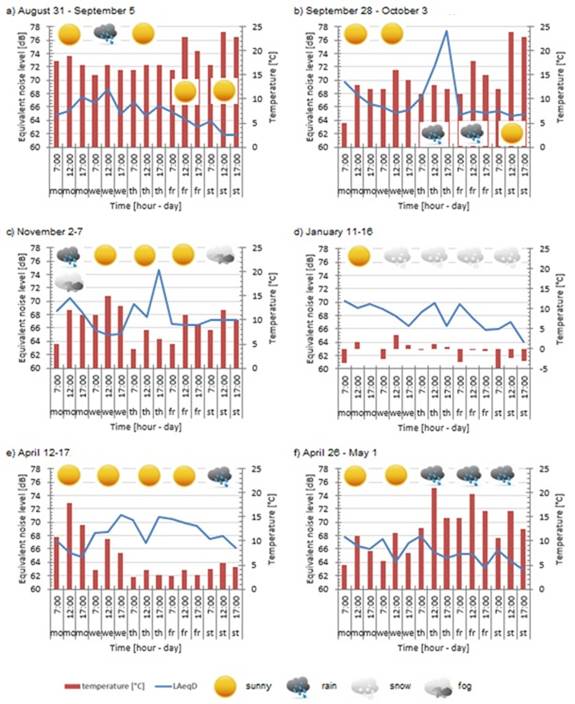
Fig. 8.
Changes in the equivalent sound level and air temperature in individual
measurement cycles at both sites
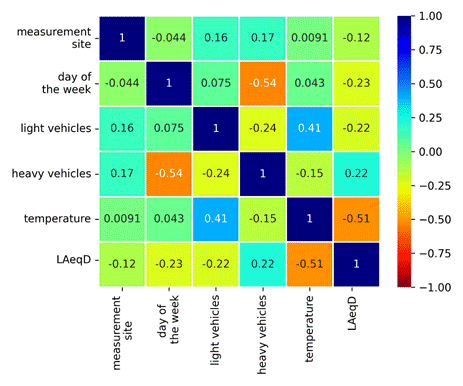
Fig. 9.
Correlation matrix of the equivalent noise level and day of the week and the
measured parameters related to the number of vehicles and weather conditions
In
the next part of the analysis, machine learning methods were used to determine
the impact of selected factors on the equivalent noise level. The highest
values of the determination coefficient were obtained using the support vector
method (Fig. 10), for which a satisfactory fit of the forecast data to the
observational data was obtained. The values of the Shapley index showed that
air temperature had the greatest impact on the fit of the forecast data. The
values of this indicator were also influenced by the day of the week, working
or not working, and from which measuring site the noise intensity data came
from.
In
the case of the neural network, the main factors that influenced the results of
the noise intensity measurements were temperature, snowfall, and season.
According to the ridge regression method, the most important factors that
influenced the noise level were temperature, day of the week (working or not),
and information about snowfall. In turn, in the nearest-neighbor
method, the most valuable information for forecasts was information about the
vegetation period, the location of the measurement site, and information about
the type of measurement day, working or non-working.
4.5.
Discussion of research results
Research
carried out showed that in Michałowice, on the DK7
road, the equivalent noise level exceeded the permitted value on weekdays and
Saturdays, which was 61 dB for the time of day. Higher values of the equivalent
noise level on weekdays, exceeding the permissible values and thus higher than
the recorded level on Saturdays, may indicate that the cause is usually higher
traffic intensity, which is confirmed, among others, by the studies of Hegewald
[23] and Abdur-Rouf and Shaaban [1].
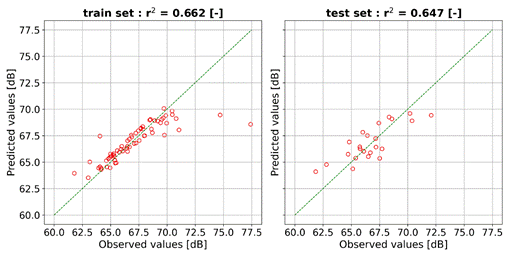
Fig. 10.
Comparison of prediction results for
the test and training set using the support vector method
In
countries of the European Union, the so-called "noise policy"
resulting from Directive 2002/49/EC of the European Parliament and of the
Council [12] on the assessment and management of environmental noise. The
directive defines objectives and tasks to reduce the harmful impact of
excessive noise on the environment. The need to prepare acoustic maps, create
"noise combat" programs, and provide residents with access to noise
information was highlighted [19]. Acoustic maps are intended to be used for a
general diagnosis of noise from various sources in a given area and to forecast
changes in the acoustic climate. Acoustic maps are the basis for the preparation
of an environmental protection program against noise. The program defines the
basic directions and scope of activities necessary to restore acceptable noise
levels in the environment.
An
acoustic map was prepared for the research site in question, which shows the
acoustic climate. An acoustic map allows you to indicate areas and the number
of people or residential premises exposed to a specific noise level. The map is
developed based on traffic noise measurements and is also the result of
modelling acoustic parameters. The research area in question is located in the
noise zone allowed for 68 dB, and the average daily traffic intensity for Michałowice ranges from 15 to 29.9 thousand vehicles (Fig.
11). According to the acoustic map, the area directly adjacent to DK7 is in the
noise emission range of 70 to 74.9 dB, and the test site itself is in the range
of 65 to 69.9 dB. Behind the building line, the
emission level is the lowest and is below 59.9 dB.
The acoustic map does not indicate any exceedance of the permissible noise
level along the analyzed research area.
As
part of the RID [43] project implemented in 2016-2018, noise intensity
measurements and traffic intensity were carried out, among others, along the
national road at the administrative border of the Michałowice
and Wilczkowice communes at a distance of
approximately 3.0 km from the research (Fig. 12). During the research period,
the section of the DK7 road in question had a single-lane 2+1 cross-section
(with a slow traffic lane), a 1.0 m wide hard shoulder, and ditches on both
sides. The width of individual lanes is approximately 3.5 m, while the width of
the entire road is 11 m. The road had a good bituminous surface with numerous
patches and local mesh cracks. The transverse unevenness of the road was not
maintained throughout the examined section and the roadsides were poorly
maintained. There is a vertical concave arch near the buildings.
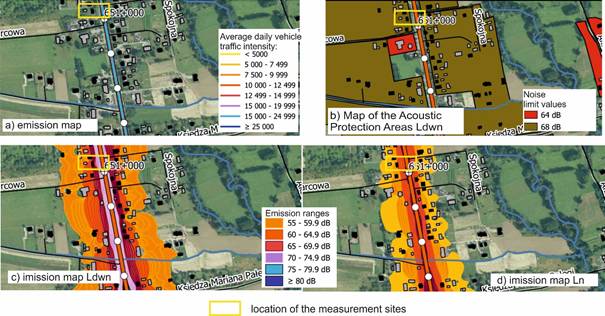
Fig. 11.
Acoustic map of the research area in Michałowice
(own study after [55])
The
development area included 6 residential buildings located in the Dłubniański Landscape Park with a cantilevered development
system (perpendicular to the access road). In terms of height, the buildings
are located approximately 2.0 m below the DK7 road and are separated from it by
an earth embankment planted with high and low greenery (trees and bushes). To
the north of the buildings there are densely planted tall deciduous trees, and
in the southern part there are arable fields. The tests were carried out on
Friday at 7 sites, the locations of which are shown in Figure 12, in three
measurement cycles lasting 15 minutes each and in two repetitions. The results
of these tests are presented in Table 2. The measurements were made on Friday
in August 2016 during the day in sunny cloudless weather and an average
temperature of 25°C.
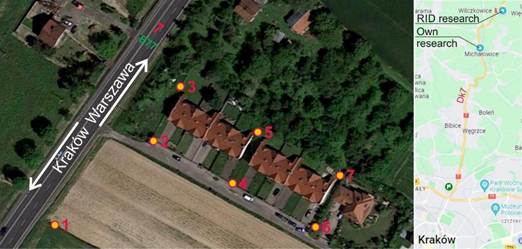
Fig. 12.
Location of the measurement sites in RID research (own study after [43, 54])
Comparing
the noise level results obtained for the period 2020-2021 with the research
conducted as part of the RID project [43] in 2017, it can be concluded that the
noise level values were similar (Table 4). Slight differences may result from
different locations of measurement sites, time of day, and measurement
duration. It can be noted that in the case of research carried out by the
National Centre for Research and Development, the distances to the noise source
and vehicle speeds were greater and the traffic intensity was lower.
In
the case of the RID study [43], the equivalent noise level near DK7 (Fig. 12 –
site 1) was the highest, and as they moved away from the road in the
development area, they decreased (Fig. 12 – sites 2 to 7). The authors stated
that the acoustic climate on the roadside will be unsatisfactory at the
beginning of the development system and will improve as we move away from it.
The research clearly shows that the existing earth embankment and greenery on
the roadside contributed significantly to noise suppression. Measurements of
noise spread in the structure of buildings in the area in question showed a
reduction in the number of buildings exposed to excessive noise as they moved
away from the road.
Tab.
4
Comparison of noise intensity test results
(own study after [43])
|
Parameter |
Measurement |
RID research
[2018] (Michałowice - Wilczkowice
border) |
Own research (Michałowice) |
||||
|
Cycle 1 |
Cycle 2 |
Cycle 3 |
Measuring site |
||||
|
Measuring point |
|||||||
|
1,2,3 |
1,4,5 |
1,6,7 |
1 |
2 |
|||
|
Distance from DK7 [m] |
25 |
75 |
125 |
11.5 |
27 |
||
|
Traffic |
[l.v. h-1]1) |
1 |
744 |
888 |
936 |
884-1402 |
1000-1508 |
|
2 |
760 |
888 |
868 |
||||
|
[h.v.×h-1]2) |
1 |
64 |
76 |
88 |
14-162 |
98-170 |
|
|
2 |
24 |
108 |
96 |
||||
|
Noise intensity
[dB] |
1 |
60.9-71.5 |
50.4-71.6 |
50.7-72.8 |
61.8-71.4 |
63.0-69.7 |
|
|
2 |
61.4-72.2 |
54.4-72.6 |
46.5-71.9 |
||||
|
1) l.v.
– light vehicles, 2) l.v. – heavy
vehicles |
|||||||
Analyzing the results
of research conducted in countries of the European Union, it should be clearly
stated that approximately 40% of its inhabitants are exposed to road noise at a
level greater than 55 dB [51]. Noise levels in EU countries do not differ from
those recorded in other countries. For example, Abdur-Rouf and Shaaban [1]
conducted research on road noise levels in the morning, afternoon, and evening
hours on weekdays and weekends in Doha, Qatar, and compared them with local
limits and the World Health Organization (WHO). As part of the investigation,
in addition to measuring sound pressure, they also measured air temperature,
humidity, and wind speed. The results obtained showed that, regardless of the
day, the average 16-hour noise levels in the selected locations exceeded the
allowed values. On weekdays, they ranged from 67.6 dB to 77.5 dB and on
weekends from 68.8 dB to 76.9 dB.
Similarly,
in other countries, many urban areas are exposed to road noise that exceeds the
limit values set by the relevant government authorities of these countries,
such as the United States [28, 33], Canada [4, 10], Brazil [9], India [48],
Pakistan [35], United Arab Emirates [16, 21]. Most of the time, high noise
levels are observed on roads located at major urban intersections, especially
in urban areas of developing countries. According to WHO, noise pollution
caused by traffic on densely congested roads can be as high as 75-80 dB [51].
However, such noise levels are noticeably higher than the allowed noise
thresholds and must be taken into account by governments, urban planners, and
policymakers alike.
For
many years, countries such as the United Kingdom, the United States, and
Australia have recognized road noise as a public health and welfare issue.
Therefore, several actions have been taken to reduce road noise levels at the
source level by controlling and limiting vehicle use, promoting environmental
awareness, introducing sustainable public transport or encouraging cycling. It
is also important that these countries have defined guidelines for road design
in noise-sensitive areas [8].
Strategies
to reduce noise levels by introducing noise-limiting vegetation zones in the
city and installing adapted acoustic screens adapted to development where
necessary [11, 36, 41, 47]. However, such activities must be related to proper
urban planning and land development. This can only be achieved in combination
with the implementation of advanced traffic management systems, such as
redirecting traffic from highly congested to less congested road networks.
4. CONCLUSION
Based
on the analysis of the noise level measurement results, it was found that its
equivalent level in individual measurement cycles carried out on the DK7 road
in Michałowice from September to May was at a similar
level. The location of the research sites and therefore the distance from the
DK7 road as a noise source did not show a significant impact on the equivalent
noise level. No significant dependencies were found that could significantly
influence the research results. Therefore, it can be concluded that loose
plantings of coniferous trees and small shrubs do not muffle the noise.
The
permissible value of the equivalent noise level for the time of day was found
to be exceeded, both for single-family development areas and for service
development areas covered by the local development plan at the measurement
site. The calculation results indicate that this exceedance occurred for each
measurement hour in all measurement cycles at both sites. The measured values
of traffic noise were at a high level in relation to the assessment of the
subjective feeling of noise annoyance, at the same time, it was an average
noise threat.
The
distribution of vehicles and the number of passing over time did not change
significantly. The exception was on Saturdays when traffic intensity was
reduced. Variations in the number of vehicles do not result in a significant
reduction in the equivalent noise level. It can be concluded that the influence
of the number of cars on the noise level may be distorted by the presence of a
speed camera a short distance from the test section. The introduction of a
speed camera along the DK7 road in Michałowice and
the D-51 road signs informing about its presence resulted in a
"calming" of road traffic and adaptation to the permissible speed.
The restrictive speed limit of 50 km×h-1
resulted in the noise level remaining at a similar level during the measurement
cycles.
The
use of machine learning methods showed that important indirect factors that
influence the level of noise generated include air temperature, snowfall, and
plant vegetation. Under Polish conditions, where the variability of atmospheric
conditions is significant, a more detailed understanding of how these changes
affect the equivalent noise level is needed. Research on this phenomenon can
contribute to the development of more effective noise management strategies,
especially in urban areas where noise is a social and health problem.
Implementing countermeasures can contribute to improving the quality of life of
residents and creating a more friendly acoustic environment. Significantly
lower noise values were obtained during the measurements carried out on the
weekend, which shows that the economic nature of traffic dominates in the analyzed road section.
The
research shows that with such a significant limitation of car speeds, the
permissible value of the equivalent noise level is exceeded. This may result in
the need to use noise-absorbing screens. It is proposed to reduce the level of
noise by increasing the planting of tree and shrub species native to our
climate zone, which will limit the range of noise impact. The use of rigid
screens would be more effective, but requires significant financial outlays,
which would also reduce the attractiveness of the plots. The construction of
the S7 Expressway, whose route is located a considerable distance from Michałowice, is also in favor of
limiting the use of rigid screens, which can result in a reduction in vehicle
traffic on the analyzed section of the road in the
future. Any measures related to the construction of an anti-noise barrier
should be preceded by a survey among the residents of Michałowice,
as well as the creation of a program co-financing possible additional plantings
of trees and shrubs.
It
should be noted that during the analysis period, Poland was in the midst of a
Covid-19 epidemic, which resulted in the introduction of restrictions that,
among other things, recommended limiting movement. The result of these
activities was reduced road traffic and, therefore, lower road noise levels.
Acknowledgments
The
authors would like to thank MSc Eng. Daniel Wywiał for his help in carrying out
the field tests presented in this paper. The authors would like to thank the
anonymous reviewers for their efforts towards improving the manuscript.
References
1.
Abdur-Rouf
K., K. Shaaban.
2022. “Measuring, mapping, and valuating Daytime Traffic Noise Levels at Urban
Road Intersections in Doha, Qatar”. Future
Transp. 2: 625-643. DOI:
10.3390/futuretransp2030034.
2.
Ahmetovic
N. 2010. Health and Environment in
Europe: Progress Assessment. Technical
Report. WHO Regional Office for Europe. ISBN: 978 92 890 4198 0.
3.
Andersson
E.M, M. Ögren, P. Molnár, D. Segersson, D. Rosengren,
L. Stockfelt.
2020. “Road traffic noise, air pollution and cardiovascular events in a Swedish
cohort”. Environmental Research 185: 109446. DOI:10.1016/j.envres.2020.109446.
4.
Apparicio
P., M. Carrier, J. Gelb, A.M. Séguin, S. Kingham. 2016. “Cyclists' exposure to air pollution and road
traffic noise in central city neighborhoods of Montreal”. J. Transp. Geogr. 57: 63-69. DOI: 10.1016/j.jtrangeo.2016.09.014.
5.
Baranowski J., K. Błażejczyk,
P. Milewski. 2014. „Klimat akustyczny w otoczeniu wybranych odcinków dróg w
Polsce – wyniki wstępne”. Prace i Studia Geograficzne 56: 17-36. [In Polish: „Acoustic climate in the surrounding
of selected sectors of roads in Poland - preliminary results”. Studies in Geography].
6.
Berge T., P. Mioduszewski, J. Ejsmont,
B. Świeczko-Żurek. 2017. „Reduction
of road traffic noise by source measures – present and future strategies”. Noise Control Engineering Journal 65(6): 6. DOI: 10.3397/1/376568.
7.
Bortkiewicz A., N. Czaja.
2018. „Pozasłuchowe skutki działania hałasu ze
szczególnym uwzględnieniem chorób układu krążenia”. Forum Medycyny Rodzinnej 2(2): 41-49. [In Polish: “Extra-hearing effects of noise, with particular
emphasis on cardiovascular diseases”. Family
Medicine Forum].
8.
Burgess
M., J. MacPherson. 2016.
“Overview of Australian Road Traffic Noise Policy”. Acoustics Australia 44: 227-234. DOI: 10.1007/s40857-016-0067-2.
9.
Calixto
A., F.B. Diniz, P.H. Zannin. 2003. “The statistical modeling of road traffic noise in
an urban setting”. Cities 20: 23-29. DOI: 10.1016/S0264-2751(02)00093-8.
10.
Carrier
M., P. Apparicio, A.M. Séguin. 2016. “Road traffic noise in Montreal and environmental
equity: What is the situation for the most vulnerable population groups?” J. Transp. Geogr. 51: 1-8. DOI: 10.1016/j.jtrangeo.2015.10.020.
11.
Drozd W. 2013. „Ekrany
akustyczne jako metoda ograniczenia emisji w infrastrukturze drogowej”. Przegląd
budowlany 12: 33-39. [In Polish:
“Noise barriers as a method of reducing emissions in road infrastructure”. Builders review].
12.
Dyrektywa 2002/49/WE
Parlamentu Europejskiego I Rady z dnia 25 czerwca 2002 r. odnosząca się do
oceny i zarządzania poziomem hałasu w środowisku. [In Polish: Directive 2002/49/EC of the European
Parliament and of the Council of 25 June 2002 relating to the assessment and
management of environmental noise.]
13. Dz.U. 2001, nr
62, poz. 627. Ustawa z dnia 27 kwietnia 2001 r. Prawo ochrony środowiska. [In Polish: Journal of Laws
2001, no. 62, item 627. Act of 27 April 2001,
Environmental Protection Law.]
14.
Dz.U. 2012, poz. 1109.
Rozporządzenie Ministra Środowiska z dnia 1 października 2012 r. zmieniające
rozporządzenie w sprawie dopuszczalnych poziomów hałasu w środowisku. [In Polish: Journal of Laws 2012, item 1109. Regulation
on the Environment Minister of the Environment of October 1, 2012 amending the
regulation on allowed noise levels in the environment.]
15.
Dz.U. 2014, poz. 112.
Obwieszczenie Ministra Środowiska z dnia 15 października 2013 r. w sprawie
ogłoszenia jednolitego tekstu rozporządzenia Ministra Środowiska w sprawie
dopuszczalnych poziomów hałasu w środowisku. [In Polish: Journal of Laws 2014, item 112. Notice from
the Minister of Environment of October 15, 2013 on the publication of the
consolidated text of the regulation of Minister of the Environment on allowed
noise levels in the environment.]
16.
Elmehdi
H.M. 2014. “Using mathematical models to predict annoyance from combined noise
sources in the city of Dubai”. In: Inter Noise; Citeseer : Melbourne, VIC,
Australia.
17.
Franklin
M., S. Fruin. 2017. “The role of traffic noise on the association
between air pollution and children's lung function”. Environmental Research 157: 153-159. DOI: 10.1016/j.envres.2017.05.024.
18.
Galli S.
2021. “Feature-engine: A Python package for feature engineering for machine
learning”. Journal of Open Source
Software 6(65): 3642. DOI: 10.21105/joss.03642.
19.
Gardziejczyk W. 2018. Hałaśliwość
nawierzchni drogowych. Oficyna Wydawnicza Politechniki Białostockiej,
Białystok. ISBN: 978-83-65596-58-1. [In Polish: Noisiness of road surfaces. Publishing
House of the Białystok University of Technology, Białystok].
20.
GUS 2021. Ochrona środowiska 2021. Główny Urząd
Statystyczny, Warszawa. ISSN: 0867-3217. [In Polish: Environment 2021. Statistics Poland, Warsaw].
21.
Hamad K.,
M. Khalil, A. Shanableh. 2017. ”Modeling roadway traffic noise in a hot climate
using artificial neural networks”. Transp.
Res. Part D Transp. Environ 53: 161-177. DOI: 10.1016/j.trd.2017.04.014
22.
Harris
C.R., K.J. Millman, S.J. van der Walt, et al.
2020. “Array programming with NumPy”. Nature
585: 357-362. DOI: 10.1038/s41586-020-2649-2.
23.
Hegewald
J., M. Schubert, M. Lochmann,
A. Seidler. 2021.
“The burden of disease due to road traffic noise in Hesse, Germany”. Int. J. Environ. Res. Public Health 18: 9337. DOI: 10.3390/ijerph18179337.
24.
Hunter
J.D. 2007. “Matplotlib: A 2D Graphics Environment”. Computing in Science & Engineering 9(3): 90-95.
DOI: 10.1109/MCSE.2007.55.
25.
Ibili F.,
E.K. Adanu, C.A. Adams, S.A. Andam-Akorful, S.S. Turay, S.A. Ajayi. 2021.
“Traffic noise models and noise guidelines: A review.” Noise & Vibration Worldwide 53: 1-2. DOI: 10.1177/09574565211052693.
26.
Kaleta T. 2022. “Wpływ
infrastruktury drogowej i kolejowej na zwierzęta dzikie”. Życie
Weterynaryjne 97(2): 81-87. [In Polish:
“The effect of roads and railways infrastructure on the wildlife”. Veterinary Life].
27.
Koszarny Z., W. Szata. 1987. „Narażenie ludności Warszawy na
hałas uliczny. Cz. I i II”. Roczniki Państwowego Zakładu Higieny 38: 1-2. [In Polish: “Traffic noise in the population of Warsaw. Part I and II”. Annals of the Polish National Institute of
Hygiene].
28.
Lee E.Y.,
M. Jerrett, Z. Ross, P.F. Coogan, E.Y. Seto. 2014. ”Assessment of
traffic-related noise in three cities in the United States”. Environ. Res. 132: 182-189. DOI: 10.1016/j.envres.2014.03.005.
29.
Lundberg
S.M., G. Erion, H. Chen, A. DeGrave, J.M. Prutkin, B. Nair, R. Katz, J. Himmelfarb, N. Bansal, Su-In
Lee. 2020. “From local explanations to global understanding
with explainable AI for trees”. Nature
Machine Intelligence 2: 56-67. DOI: 10.1038/s42256-019-0138-9.
30.
Lundberg
Scott M., Su-In Lee. 2017. “A unified approach to interpreting model
predictions”. In: Proceedings of 31st
Conference on Neural Information Processing Systems (NIPS 2017), Long Beach,
CA, USA: 1-10. ISBN: 9781510860964.
31.
Malec M., S. Klatka, E. Kruk,
M. Ryczek. 2017. „Próba oceny wpływu roślinności na kształtowanie krajobrazu
dźwiękowego na przykładzie dwóch parków miejskich Krakowa”. Acta.
Sci. Pol., Formatio Circumiectus 16(2): 167-178. DOI: 10.15576/ASP.FC/2017.16.2.167.
[In Polish: „An attempt to assess the impact of vegetation on the soundscape on
example two urban parks in Krakow”. Acta.
Sci. Pol., Formatio Circumiectus].
32.
Margaritis
E., J. Kang, K. Filipan, D. Botteldooren, 2018. “The influence of vegetation and
surrounding traffic noise parameters on the sound environment of urban parks”. Applied Geography 94: 199-212. DOI: 10.1016/j.apgeog.2018.02.017.
33.
McAlexander
T.P., R.R.M. Gershon, R.L. Neitzel. 2015. “Street-level noise in an urban setting:
assessment and contribution to personal impact”. Environ. Health 14: 18. DOI: 10.1186/s12940-015-0006-y.
34.
McKinney
W. 2010. “Data structures for statistical computing in python”. In: Proceedings
of the 9th Python in Science Conference SciPy 2010: 51-56. DOI: 10.25080/Majora-92bf1922-012. June 28 - July 3 2010,
Austin, Texas.
35.
Mehdi
M.R., M. Kim, J.C. Seong, M.H. Arsalan. 2011. “Spatio-temporal patterns of road
traffic noise pollution in Karachi, Pakistan”. Environ. Int. 37: 97-104. DOI: 10.1016/j.envint.2010.08.003.
36.
Ow L.F.,
S. Ghosh. 2017.
“Urban cities and road traffic noise: Reducing through vegetation”. Appl. Acoust. 120: 15-20. DOI: 10.1016/j.apacoust.2017.01.007.
37.
Pedregosa
, F., G. Varoquaux, A. Gramfort, V. Michel,
B. Thirion, O. Grisel, M. Blondel, P. Prettenhofer, R. Weiss, V. Dubourg, J. Vanderplas, A. Passos,
D. Cournapeau, M. Brucher, M. Perrot, E. Duchesnay. 2011. “Scikit -learn: Machine Learning in
Python”. Journal of Machine Learning
Research 12: 2825-2830.
38.
PN-EN 61672-1:2014-03. Elektroakustyka. Mierniki poziomu dźwięku.
Część 1: Wymagania. Warszawa: Polski Komitet Normalizacyjny. [In Polish: PN-EN 61672-1:2014-03. Electroacoustics. Sound level meters. Part 1:
Requirements. Warsaw: Polish Committee of
Standardization].
39.
PN-ISO 1996-1:2006. Akustyka. Opis, pomiary i ocena hałasu
środowiskowego. Część 1: Wielkości podstawowe i procedury oceny. Warszawa:
Polski Komitet Normalizacyjny. [In
Polish: PN-ISO 1996-1:2006. Acoustics.
Description, measurement and assessment of environmental noise. Part 1: Sizes
basic and procedures grades. Warsaw: Polish Committee of Standardization].
40.
Poniatowski
P. 2022. “The Legal Basis for Protection against Road Traffic Noise: An Outline of the Issue. Part One”. Studies Iuridica Lublinensia 31: 1. DOI: 10.17951/sil.2022.31.1.135-148.
41.
Potvin
S., P. Apparicio, A.M. Séguin. 2019. “The spatial distribution of noise barriers in
Montreal: A barrier to achieving environmental equity”. Transp. Res. Part D Transp. Environ. 72: 83-97. DOI: 10.1016/j.trd.2019.04.011.
42.
Puyana-Romero
V., J.L. Cueto, R. Gey. 2020. “A 3D GIS tool for the detection of noise hot-spots
from major roads”. Transportation
Research Part D: Transport and Environment 84: 102376. DOI: 10.1016/j.trd.2020.102376.
43.
RID 2018. Rozwój
Inicjatyw Drogowych. Projekt RID I/76, Ochrona przed hałasem drogowym. Zadanie
7. Kształtowanie urbanistyczne układów droga w aspekcie ochrony akustycznej
ochrony mieszkańców przed hałasem.
Available at: http://www.archiwum.gddkia.gov.pl/frontend/web/userfiles/articles/w/wyniki-projektu-rid-ochrona-prze_33468/Zadanie_7.pdf. [In Polish: Development of Road Initiatives. Project RID
I/76, Protection against road noise. Task 7. Shaping urban road layouts in
terms of acoustic protection and protection of residents against noise].
44.
Shannon
G., L.M. Angeloni, G. Wittemyer, K.M. Fristrup, K.R. Crooks. 2014.
“Road traffic noise modifies behavior of a keystone species”. Animal Behavior 94: 135-141. DOI: 10.1016/j.anbehav.2014.06.004.
45.
Szyszlak-Bargłowicz J., T. Słowik, G. Zając. 2012. „Zanieczyszczenia
środowiska hałasem komunikacyjnym na terenie Parku Krajobrazowego Pogórza
Przemyskiego”. Autobusy: technika,
eksploatacja, systemy transportowe 13(10): 144-147. [In Polish:
Traffic noise pollution of the Park Krajobrazowy Pogórza Przemyskiego”. Buses:
technology, operation, transport systems].
46.
Titu
A.M., A.A. Boroiu, S. Mihailescu, A.B. Pop, A. Boroiu. 2022. “Assessment of
road noise pollution n urban residential areas - a case study in Piteşti,
Romania”. Appl. Sci. 12: 4053. DOI: 10.3390/app12084053.
47.
Van
Renterghem T. 2019. “Towards explaining the positive effect of vegetation on
the perception of environmental noise”. Urban
Forestry & Urban Greening 40: 133-144. DOI: 10.1016/j.ufug.2018.03.007.
48.
Vilas P.,
N.P. Prashant. 2015.
“Measurement and Analysis of Noise at Signalized Intersections”. Journal of Environmental Research And
Development 9(03): 662-667.
49.
Virtanen
P., R. Gommers, T.E. Oliphant, et al. 2020. “SciPy 1.0: fundamental algorithms for
scientific computing in Python”. Nature
Methods 17: 261-272. DOI: 10.1038/s41592-019-0686-2.
50.
Waskom
M.L. 2021. “Seaborn: statistical data visualization”. Journal of Open Source Software 6(60): 3021. DOI:10.21105/joss.03021.
51.
WHO 2019.
“Environmental noise guidelines for the European Region”. World Health
Organization. Regional Office for Europe. Copenhagen, Denmark. Available at:
http://www.who.int.
52.
Wrótny
M., J. Bohatkiewicz. 2021.
“Traffic Noise and Inhabitant Health – A
Comparison of Road and Rail Noise”. Sustainability
13: 7340. DOI: 10.3390/ su13137340.
53.
Noise – European Environment Agency. Available at:
http://www.eea.europa.eu/en/topics/in-depth/noise.
54.
Google maps. Available at: http://www.google.maps.pl.
55.
Strategic
noise maps. Available at: http://www.gov.pl/web/gddkia/strategiczne-mapy-halasu-2022.
56.
Noise – World Health Organization. Available at:
http://www.who.int/europe/news-room/fact-sheets/item/noise.
Received 08.10.2024; accepted in revised form 28.01.2025
![]()
Scientific Journal of Silesian
University of Technology. Series Transport is licensed under a Creative
Commons Attribution 4.0 International License



